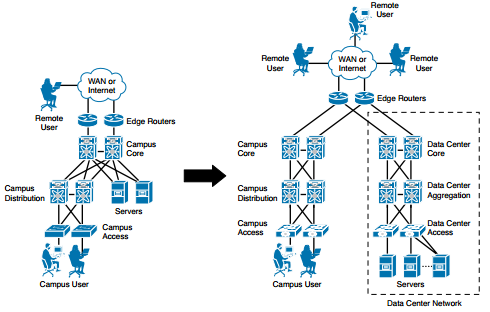210-451 CCNA Cloud CLDFND FAQ – Network Architectures for the Data Center Unified Fabric
Q1. Which of the following is not an expected quality of a data center network?
a. Availability
b. Scalability
c. Flexibility
d. User authentication
e. Manageability
Q2. Which of the following represent the main distinctions between data center and campus networks? (Choose all that apply.)
a. Campus networks follow three-tier designs with core, aggregation, and access layers.
b. Majority of traffic direction (east-west versus north-south).
c. Number of connections on a single host.
d. Data center networks generally are considered a more secure environment.
Q3. Which of the following does not represent a function of the aggregation layer on a three-tier data center network design?
a. Default gateway for the servers
b. Supports east-west traffic between servers connected to different access switches
c. Routing protocol peering with external networks
d. STP root
Q4. Which of the following is correct regarding virtual device contexts?
a. You cannot configure two VRF instances with the same name in two different VDCs.
b. With VDCs, a switch can deploy more than 4094 VLANs.
c. You can control the number of VLANs, VRF instances, and MAC addresses each VDC can have.
d. It is possible to allow traffic between two VDCs through the switch backplane.
e. VDCs are a scalable solution for multitenant data centers.
Q5. Which of the following is incorrect regarding virtual PortChannels?
a. They allow two switches to behave like a single device.
b. Although it is not a good practice, the peer-keepalive probes can traverse the peer trunk.
c. You can form a peer trunk with only one physical connection.
d. Primary and secondary roles must be established between the two switches.
e. Using vPC eliminates the need for STP.
Q6. Which of the following is not correct regarding Fabric Extenders?
a. They cannot work without connecting to a parent switch.
b. They create logical interfaces in the parent switch.
c. They allow the connection of FCoE-enabled devices.
d. They allow the connection of STP-enabled devices.
e. They allow the connection of LACP-enabled devices.
Q7. Which of the following is incorrect regarding Overlay Transport Virtualization?
a. Allows VLAN extension between multiple sites
b. Can use multicast or unicast-only backbones between data center sites
c. Blocks broadcast traffic
d. Blocks STP
e. Blocks unknown unicast frames
Q8. Which of the following options are not required on Fibre Channel over Ethernet connections?
a. 10-Gigabit Ethernet or higher
b. Fiber connection
c. ETS
d. PFC
e. DCBX
Q9. Which protocol is responsible for both OTV and FabricPath MAC address updates?
a. Ethernet
b. OSPF opaque TLVs
c. IS-IS
d. MP-BGP
e. OTV and FabricPath do not share the same protocol for updates.
Q10. Which of the following is not an advantage of spine-leaf topologies over threetier designs?
a. Bandwidth scalability
b. Simplicity
c. Flexibility
d. Rapid STP
More Resources
